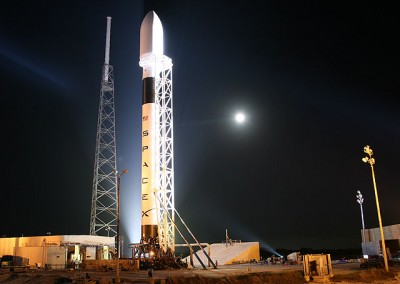Hawthorne / Los Angeles County based SpaceX is celebrating a monumental breakthrough today after a successful first launch of its Falcon 9 rocket.
I followed the launch via video feed from Cape Canaveral this morning. At first I was disappointed when the initial launch attempt resulted in a lock-down just at the moment of ignition. I thought for sure it was a scrub. But the launch window was still open. After the countdown clock was reset, everything worked well on the second try. About 10 minutes later, the upper stage with a mock-up of the proposed Dragon crew capsule entered into a low Earth orbit.
This was the inaugural flight of Falcon 9, intended for testing only. What does it mean?
First of all, SpaceX is again proving the doubters wrong. It has shown that a relatively new, relatively small company can successfully design, build and fly a launch vehicle into space. It does so better, faster and cheaper than NASA, which is so stuck in a quagmire of politics, personal maneuvering and a bureaucratic approach to engineering and innovation that it has completely failed to come up with any new launch vehicle in 25 years.
As if it were big news that the remaining three Space Shuttles, with their system history of 25 years of service (and 2 fatal accidents) are more than ready for their final flights to a museum. Nor should it be a big surprise that without the Shuttle and without any alternatives, the U.S. again lacks the capacity for manned flights to space. This means that the U.S. has no autonomous access to the ISS. In 25 years of shuttle operations, NASA could not come up with anything flightworthy?
And the aerospace giants, such as Boeing and Lockheed-Martin? They had no motivation to design anything new and cheaper. For what? To make their existing satellite launch hardware obsolete? Conveniently, they have a captive market for satellite launches. That’s because U.S. law prohibits the launch of many U.S. payloads on foreign launch vehicles. It’s a matter of “national security”, we are told. How come the Europeans are less concerned about that? They all partner with each other and with Russia to launch their payloads.
Manned flights? A crew capsule? Perhaps the aerospace giants could have been given funding to make their satellite launch vehicles (or derivatives) safe enough for human flight. (I suspect NASA and its political backers wanted none of that).
There is an interesting parallel in Formula 1 motor racing. History has shown that small, agile racing teams, with factory sponsorship and with a small, dynamic workforce are overall outperforming teams run by large car manufacturers.
In the crazy world of high-tech motorsports, there is intense competition. Teams must work around the clock to continuously innovate, learn from mistakes, outmaneuver the opponents and adapt to changes. Every race is different, and new challenges (and regulations) appear all the time.
Whoever can adapt the fastest is the most likely to arrive first at the finish line. On the racing circuit, the big car companies are like bulls racing against greyhounds. Not even Fiat-owned Ferrari is an exception. Aware that Ferrari is a national obsession and sacred to Italians, Fiat bosses are smart enough to leave it largely alone. Ferrari’s engineers and technical managers have broad decision making powers and are not micromanaged by the Fiat-Board and bean counters.
Yes, one will often find the name plates of well known automobile manufacturers on engines and other critical components. But this does not mean that Mercedes-Benz or Ford really do the R&D for these highly specialized machines. They often hire contractors — small, agile teams of experts — to solve specific problems and come up with engineering solutions, in the least amount of time. Examples of such specialty engineering firms are Cosworth and Ilmor, both in the UK, and Dallara in Italy.
This kind of structure and engineering management is exactly what is needed if we want to achieve a drop in cost, along with more reliability, in space transportation. NASA, I am afraid, is in its current state incapable of this kind of agile management and risk-taking approach. I speculate that if NASA entered a team in Formula 1, it could be initially competitive by hiring experts from other teams. But it would spend a multiple of other teams to do so and fall behind after a few years. (Oh, how I wish to see everyone on the race track!)
Meanwhile, the future for SpaceX glistens with rocket fuel right now. Of course, one successful launch doth not make a reliable launch vehicle. A lot of further tests will be needed until Falcon 9 could be deemed safe enough to fly humans to the ISS, which is the eventual goal.
If successful, SpaceX will be able to do this in less time and for a lot less money than NASA’s ill conceived Constellation program which, in typical NASA fashion, remains stuck in the mud.
Addendum June 7, 2010: In a press release today, SpaceX claims that it developed the entire Falcon 9 system, the Dragon spacecraft and the launch hardware for what it would cost NASA to build just the Ares 1 launch tower. SpaceX has only about 1,000 employees to date.
Please also see my earlier, related post on NASA’s lingering Constellation program.




